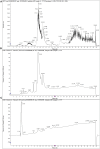Efficacy of Jasminum subtriplinerve Extract against 7,12-Dimethylbenz[ a]anthracene-Induced Cancer in Mice
- PMID: 39317690
- PMCID: PMC11637824
- DOI: 10.4014/jmb.2407.07045
Efficacy of Jasminum subtriplinerve Extract against 7,12-Dimethylbenz[ a]anthracene-Induced Cancer in Mice
Abstract
Jasminum subtriplinerve Blume tea is a traditional Vietnamese medicine used to treat impetigo, menstruation issues, and painful menstrual hematometra. Previous studies have shown that extracts and isolated compounds from J. subtriplinerve possess diverse pharmacological properties, such as antioxidant, antibacterial, and antidiabetic effects. However, their potential anticancer effects and underlying mechanisms of action have not been clear. Here, we examined the effects of J. subtriplinerve extracts against three human cancer cell lines. We also conducted in vivo analyses using a mouse model of 7,12-dimethylbenz[a]anthracene-induced breast cancer, including an investigation of changes in histological sections. The effect of the J. subtriplinerve ethyl acetate fraction on cytokine levels (IL-2, PGE2, TNF-α) in serum was determined using ELISA kits. Results showed that the ethyl acetate (EtOAc) fraction had the highest anti-proliferative activity (IC50 = 13.7 mg/ml) against the breast cancer (MCF-7) cell line, while the butanol (BuOH) and water fractions did not show any anticancer effects. Additionally, the EtOAc fraction at a dose of 14.4 mg/kg was able to elevate IL-2 levels and suppress the expression of PGE2 in the serum of mice. A remarkable decrease in the percentage of death and tumor incidence in mice was achieved following treatment with the EtOAc fraction at a dose of 14.4mg/kg. No abnormal parameters in blood were observed in the J. subtriplinerve treatment groups. These results suggest that J. subtriplinerve, when used as tea or a functional food, is nontoxic and has clear chemopreventive effects against breast cancer.
Keywords: DMBA; IL-2; Jasminium subtriplinerve Blume; breast cancer.
Conflict of interest statement
The authors have no financial conflicts of interest to declare.
Figures







References
-
- Li M, Duan Y, Wang Y, Chen L, Abdelrahim ME, Yan J. The effect of Green green tea consumption on body mass index, lipoprotein, liver enzymes, and liver cancer: an updated systemic review incorporating a meta-analysis. Crit. Rev. Food Sci. Nutr. 2024;64:1043–1051. doi: 10.1080/10408398.2022.2113360. - DOI - PubMed
MeSH terms
Substances
LinkOut - more resources
Full Text Sources

